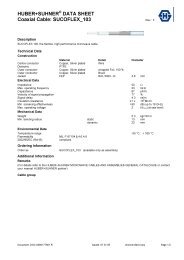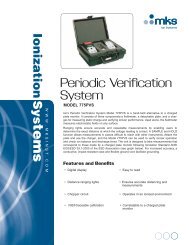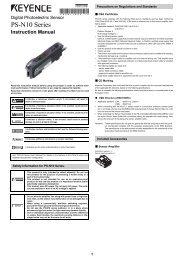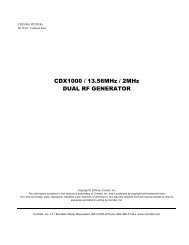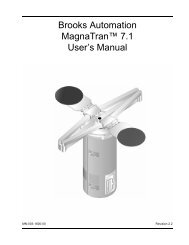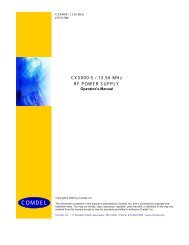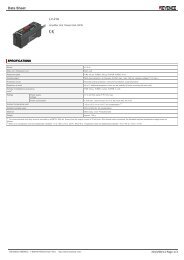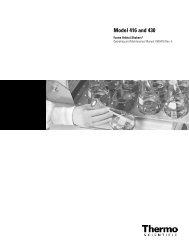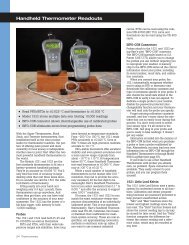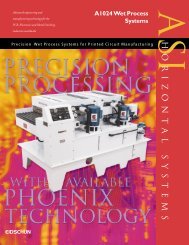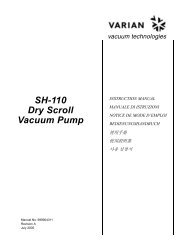Fybroc Division series 1500 horizontal pumps - MHz Electronics, Inc
Fybroc Division series 1500 horizontal pumps - MHz Electronics, Inc
Fybroc Division series 1500 horizontal pumps - MHz Electronics, Inc
Create successful ePaper yourself
Turn your PDF publications into a flip-book with our unique Google optimized e-Paper software.
PIPING THE PUMPPiping must not be connected to the pump untilbase, pump, and driver are initially aligned, failureto do so may result in the inability to attain properalignment later.All flanged connections to the pump should be fullflat face with full contact gaskets. Raised faceflanges or partial contact gaskets should not beused as excessive strains can be applied to thepump flanges upon tightening.The pump has been designed with all necessarystrength factors for long, reliable service life.However, due to the composite construction, caremust be taken during installation to avoid unnecessarypipe strain. If severe piping strains are to beencountered, flexible connections are recommendedin the suction and discharge pipe lines. Whenlined piping is used, flange alignment should becarefully checked. Spacer ring gaskets are recommendedto assure parallel alignment of pipe andpump flanges. The following flange bolt torquevalues should be used:Flange SizeBolt Torque1 1/2” 9-12 ft-lbs2” 18-24 ft-lbs3” 23-30 ft-lbs4” 27-36 ft-lbs6” & Larger 35-50 ft-lbsAll piping must be supported independently of thepump. The piping should always line up naturallywith the pump flanges. Never draw the piping to thesuction or discharge flanges of the pump. Outsideinstallations should be properly compensated forchanges in ambient temperatures. Refer to pipemanufacturers standards for proper installation.Omission of this could result in severe straintransmitted to the pump flanges.The piping should be as short and direct as possible.Avoid all unnecessary elbows, bends and fittings, asthey increase friction losses in the piping.SUCTION PIPINGA) To minimize friction loss, the length of the suctionpipe (from process to pump inlet) should be asshort as possible. It is important that NPSHavailable to the pump is greater than theNPSH required by the pump, long suction runsgreatly affect NPSH and should be consideredcarefully. See pump performance curve forNPSH requirements.B) The diameter of the suction pipe should be aslarge as the pump suction. If long suction runsare encountered, the suction pipe diametershould be increased to reduce the NPSHrequired.C) <strong>Inc</strong>reasers or reducers, if used, should beeccentric and installed with the eccentric sideon the bottom of the pipe to prevent air traps.D) Elbows, fittings, valves or expansion jointsshould be avoided at the suction flange. Allowa straight run of at least 10 pipe diameters intothe suction of the pump.E) If a valve is to be installed in the suction piping,only full flow valves offering a minimumflow disturbance should be used (ball, plugtypes). These valves should be for shut-offonly when the pump is not running, and not forthrottling or controlling flow. Centrifugal <strong>pumps</strong>should never be throttled on the suction side.F) Provisions for a suction pressure gauge shouldbe included.DISCHARGE PIPINGA) Installation of a valve in the discharge line thatcan be used as a block for inspection andmaintenance is recommended. It should be ofa design to allow throttling or flow control.B) The diameter of the discharge pipe should beas large or larger than the pump discharge.C) Provision for a discharge pressure gaugeshould be included.ANCILLARY PIPINGA) The diameter of the ancillary or seal pipingshould be large enough to meet the seal flushingrequirements. Typically this is 1/4-1/2 GPMat a pressure of 15-25 PSI above the suctionpressure for most mechanical seals. Refer topages 25 and 26 for recommended seal flushflow rates and piping installations.5



